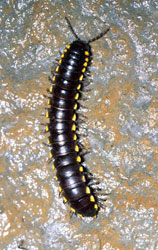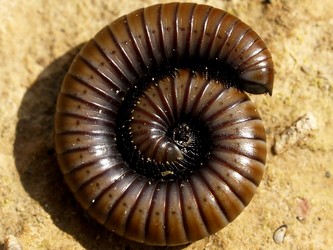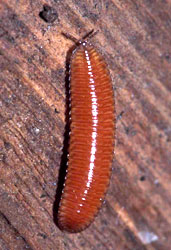Diplopoda
Millipedes



This tree diagram shows the relationships between several groups of organisms.
The root of the current tree connects the organisms featured in this tree to their containing group and the rest of the Tree of Life. The basal branching point in the tree represents the ancestor of the other groups in the tree. This ancestor diversified over time into several descendent subgroups, which are represented as internal nodes and terminal taxa to the right.

You can click on the root to travel down the Tree of Life all the way to the root of all Life, and you can click on the names of descendent subgroups to travel up the Tree of Life all the way to individual species.
For more information on ToL tree formatting, please see Interpreting the Tree or Classification. To learn more about phylogenetic trees, please visit our Phylogenetic Biology pages.
close boxReferences
Blower, J. G. 1985. Millipedes. Synopses of the British Fauna (New Series). No 35. The Linnean Society of London.
Enghoff, H. 1984. Phylogeny of millipedes - a cladistic analysis. Zeitschrift für zoologische Systematik und Evolutionsforschung 22:8-26.
Enghoff, H. 1990. The ground-plan of chilognathan millipedes (external morphology). Pages 1-24 in Proceedings of the 7th International Congress of Myriapodology. A. Minelli, ed. E. J. Brill, Leiden.
Enghoff, H., W. Dohle, and J. G. Blower. 1993. Anamorphosis in millipedes (Diplopoda)- the present state of knowledge with some developmental and phylogenetic considerations. Zoological Journal of the Linnean Society 109:103-234.
Golovatch, S. I., R. L. Hoffman, J. Adis, and J. W. Demorais. 1995. Identification plate for the millipede orders populating the Neotropical region south of Central Mexico (Myriapoda, Diplopoda). Studies on Neotropical Fauna and Environment 30:159-164.
Hoffman, R. L. 1979. Classification of the Diplopoda. Museum d'Histoire Naturelle, Genève.
Hoffman, R. L., S. I. Golovatch, J. Adis, and J. W. Demorais. 1996. Practical keys to the orders and families of millipedes of the Neotropical region (Myriapoda: Diplopoda). Amazoniana 14:1-35.
Hopkin, S. P. and H. J. Read. 1992. The Biology of Millipedes. Oxford University Press, Oxford.
Jeekel, C. A. W. 1970. Nomenclator generum et familiarum Diplopodorum: a list of the genus and family-group names in the Class Diplopoda from the 10th edition of Linnaeus 1758 to the end of 1957. Monografieen van de Nederlandsche Entomologische Vereeniging, Number 5.
Kime, R. D. and S. I. Golovatch. 2000. Trends in the ecological strategies and evolution of millipedes (Diplopoda). Biological Journal of the Linnean Society 69:333-349.
Shear, W. A. 1998. The fossil record and evolution of the myriapods. Pages 211-220 in Arthropod Relationships. Systematics Association Special Volume Series 55. R. A. Fortey and R. H. Thomas, eds. Chapman & Hall, London.
Shear, W. A. 1999. Millipeds. American Scientist 87:232-239.
Shelley, R. M. 2007. Taxonomy of extant Diplopoda (Millipeds) in the modern era: Perspectives for future advancements and observations on the global diplopod community (Arthropoda: Diplopoda). Pages 343-362 in: Zhang, Z.-Q. & Shear, W.A., eds. Linnaeus Tercentenary: Progress in Invertebrate Taxonomy. Zootaxa 1668:1–766.
Sierwald, P., W. A. Shear, R. M. Shelley, and J. E. Bond. 2003. Millipede phylogeny revisited in the light of the enigmatic order Siphoniulida. Journal of Zoological Systematics & Evolutionary Research 41(2):87-99.
Information on the Internet
- Milli-PEET. Taxonomy, Systematics and Evolution of the Diplopoda.
- Centre International de Myriapodologie. International Society of Myriapodology and Onychophorology.
- Herper.com's Millipede Pages.
Title Illustrations

| Scientific Name | Harpaphe haydeniana |
|---|---|
| Location | Kings Valley, Benton County (Oregon, US) |
| Comments | Flat-backed millipede |
| Specimen Condition | Live Specimen |
| Source Collection | CalPhotos |
| Copyright | © 2000 William Leonard |
| Scientific Name | Ommatoiulus rutilans |
|---|---|
| Location | Montoliu de Lleida, Catalonia, Spain |
| Specimen Condition | Live Specimen |
| Source | Milpeus - Milpiés - Millipede (Ommatoiulus rutilans) 6 |
| Source Collection | Flickr |
| Image Use |
 This media file is licensed under the Creative Commons Attribution-NonCommercial-ShareAlike License - Version 2.0. This media file is licensed under the Creative Commons Attribution-NonCommercial-ShareAlike License - Version 2.0.
|
| Copyright | © 2008 Ferran Turmo Gort |
| Scientific Name | Octoglena anura |
|---|---|
| Location | Kennedy Creek, Mason County (Washington, US) |
| Specimen Condition | Live Specimen |
| Source Collection | CalPhotos |
| Copyright | © 2000 William Leonard |
About This Page
Page copyright © 2002
 Page: Tree of Life
Diplopoda. Millipedes.
The TEXT of this page is licensed under the
Creative Commons Attribution-NonCommercial License - Version 3.0. Note that images and other media
featured on this page are each governed by their own license, and they may or may not be available
for reuse. Click on an image or a media link to access the media data window, which provides the
relevant licensing information. For the general terms and conditions of ToL material reuse and
redistribution, please see the Tree of Life Copyright
Policies.
Page: Tree of Life
Diplopoda. Millipedes.
The TEXT of this page is licensed under the
Creative Commons Attribution-NonCommercial License - Version 3.0. Note that images and other media
featured on this page are each governed by their own license, and they may or may not be available
for reuse. Click on an image or a media link to access the media data window, which provides the
relevant licensing information. For the general terms and conditions of ToL material reuse and
redistribution, please see the Tree of Life Copyright
Policies.
Citing this page:
Tree of Life Web Project. 2002. Diplopoda. Millipedes. Version 01 January 2002 (temporary). http://tolweb.org/Diplopoda/2532/2002.01.01 in The Tree of Life Web Project, http://tolweb.org/











 Go to quick links
Go to quick search
Go to navigation for this section of the ToL site
Go to detailed links for the ToL site
Go to quick links
Go to quick search
Go to navigation for this section of the ToL site
Go to detailed links for the ToL site